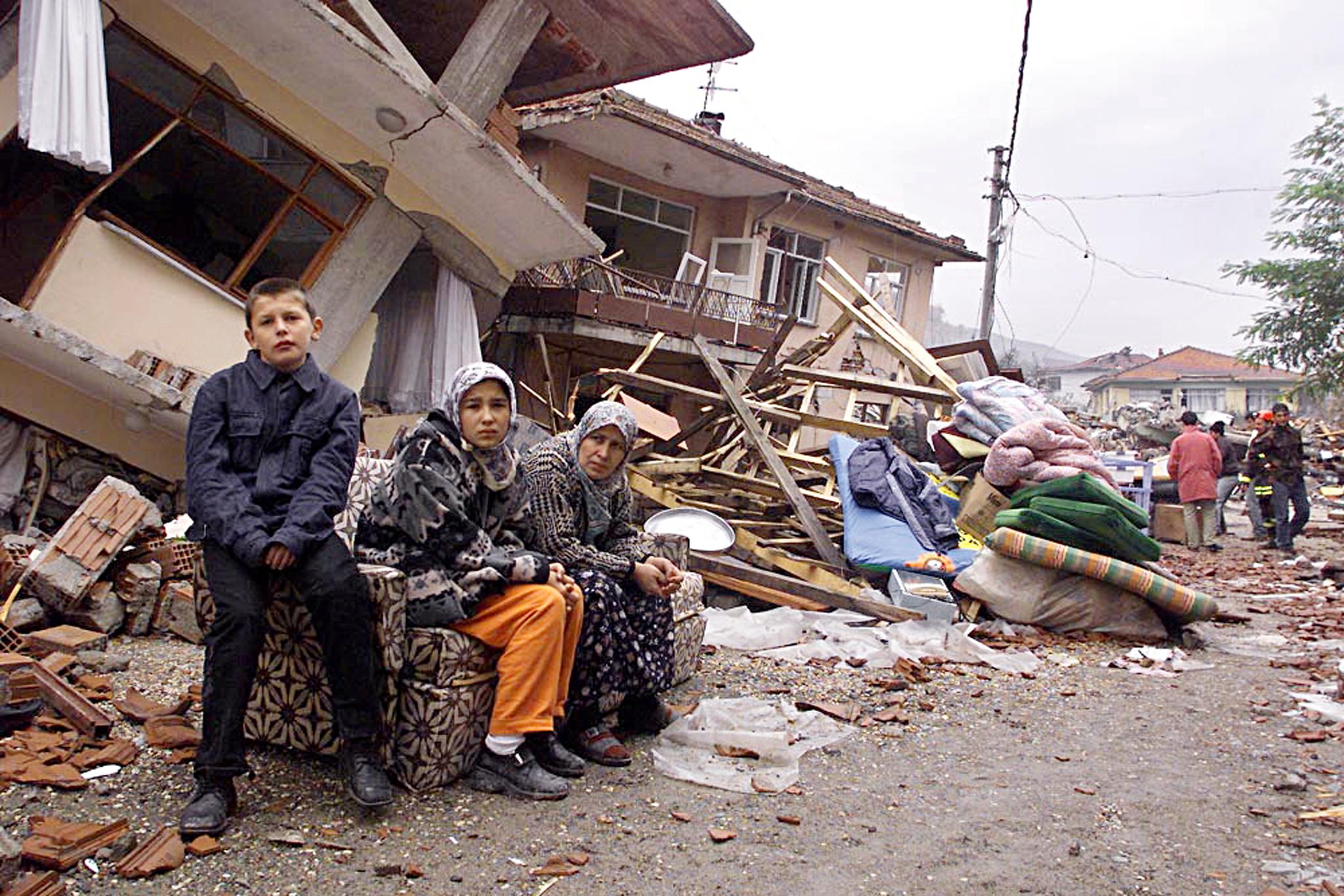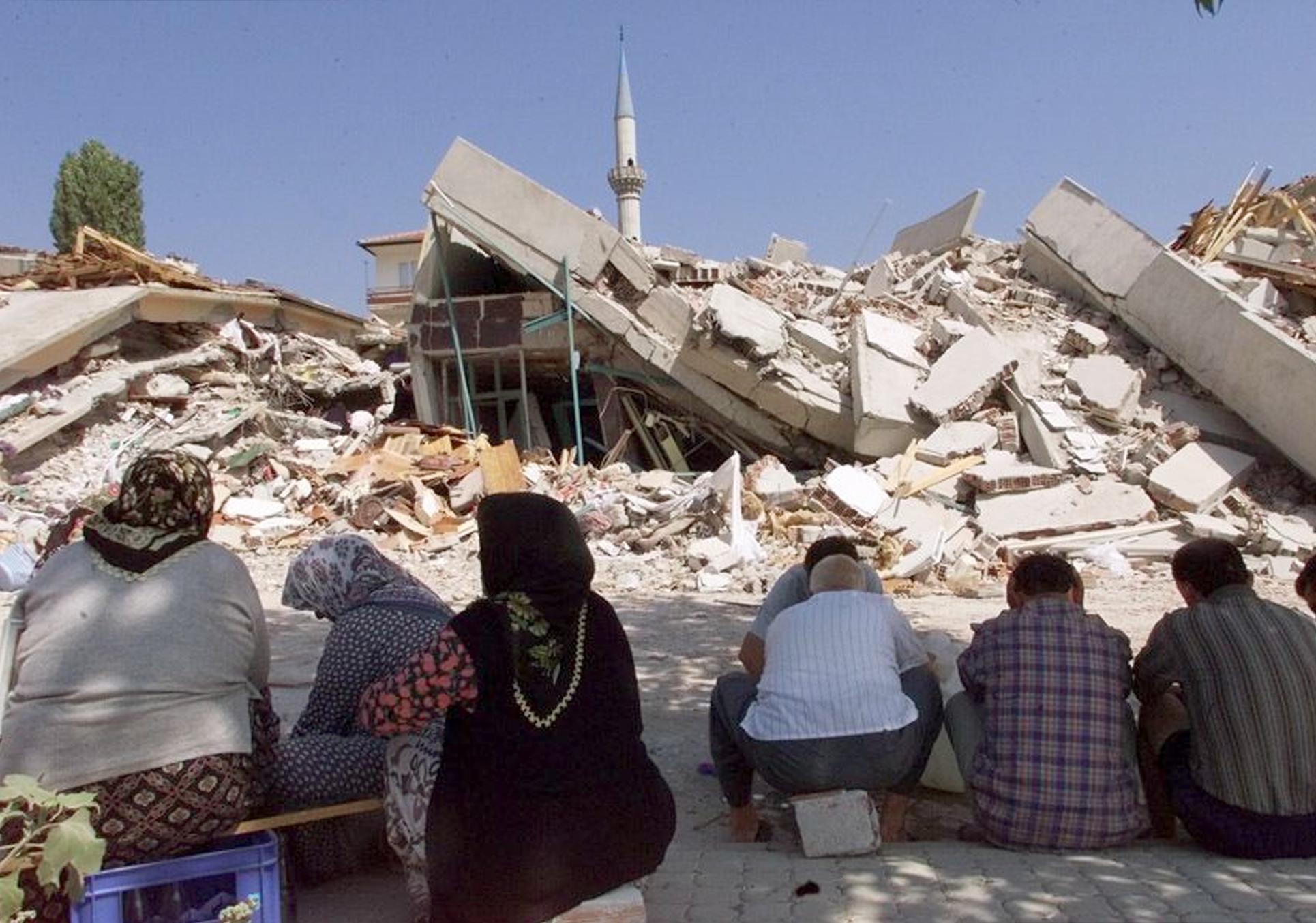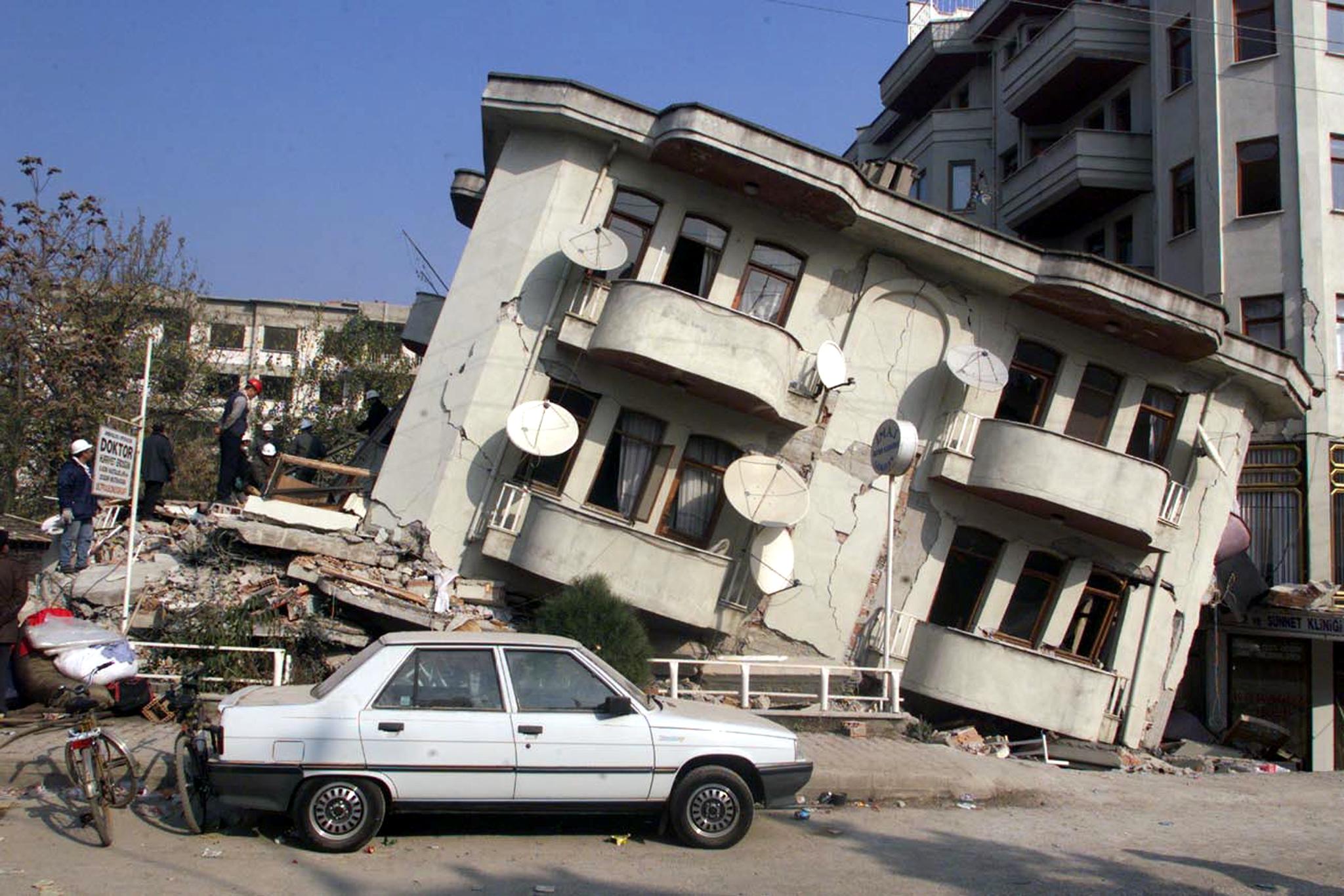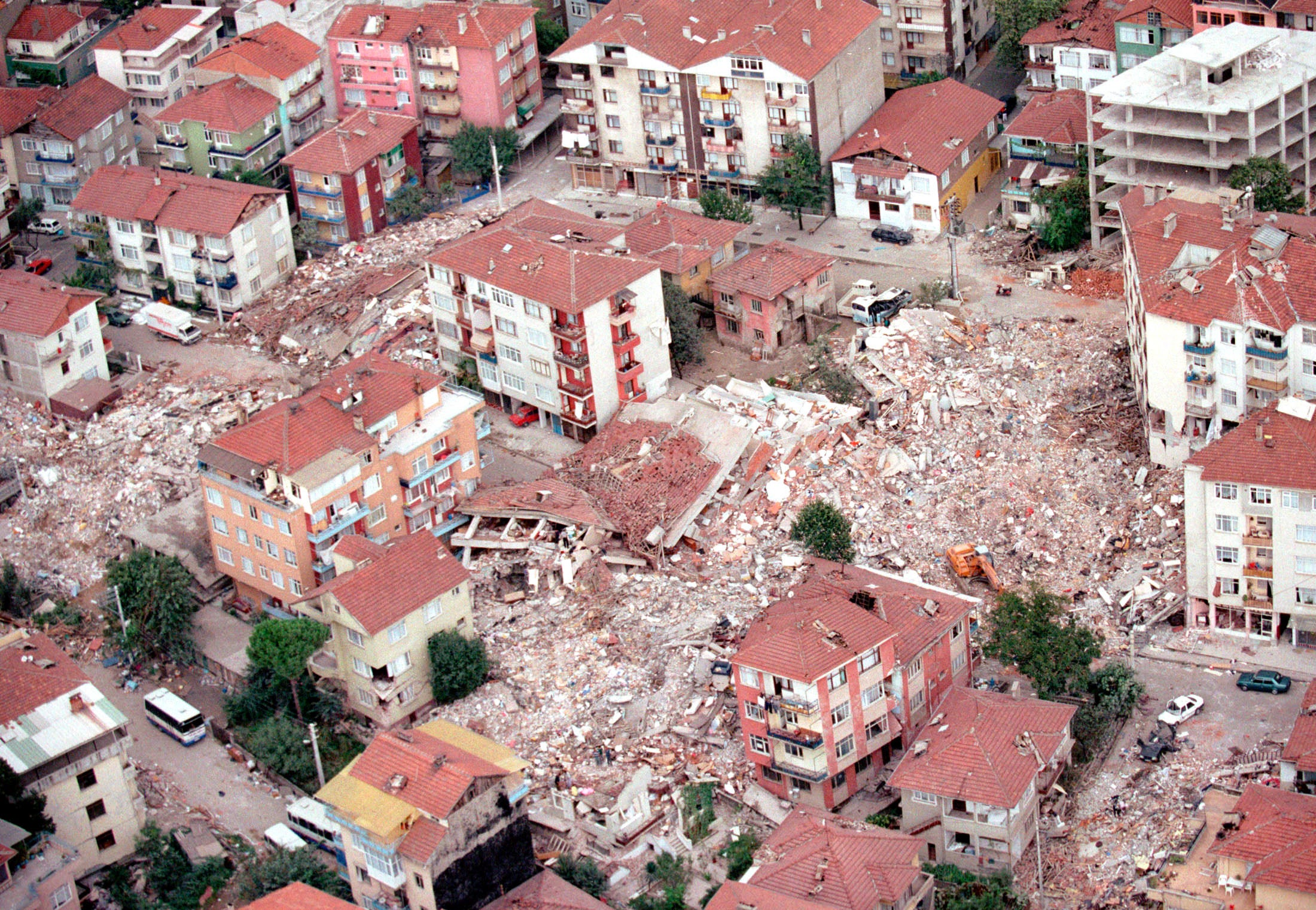The dogs howled, as the army slumbered on: Horror of a Turkish earthquake
August 1999: Robert Fisk speaks to the people caught in a terrible earthquake in Turkey and asks, where was the military?


At around 3am on Saturday 14 August, Kanieh Topal woke in her three-storey apartment block in the western suburbs of Izmit to hear a strange sound. “All the dogs were howling,” she said. “They didn’t bark, they howled – like this.” And Mrs Topal made a high, ululating sound like a woman in mourning. “The dogs made the same sound on Sunday and again in the early morning on Monday. Then the cat sat on the floor, gripping the carpet with her claws.” On the other side of the road, her neighbour Kadir Akgul remembers the dogs on the Monday night, howling “not like dogs but wolves”.
Nature, it seems, was trying to warn the people of Izmit and Yalova and Golcuk and Istanbul and a thousand other towns and villages across 450 miles of Turkey. Twelve miles beneath them, the great tectonic plates of the north Anatolian rock fault had begun to move again. On Monday, they say in Yalova, the birds went silent but began to fly from tree to tree, never resting on a branch for more than a few seconds.
At 3 o’clock on Tuesday morning – exactly 24 hours after the dogs had given the people of Izmit their final warning – the 12-mile deep fissure cracked, snapping open the earth’s crust and visiting desolation on the sleeping humans above. In the space of 45-90 seconds – some buildings took longer to collapse than others – well over 100,000 apartment blocks, hotels, hospitals, shops, factories and private houses thundered to the ground in what one survivor described as an “atomic” explosion. Some describe its effect as “evil” – the cracks veining the walls of luxury homes, the shrieks of people ripped apart between elevators, walls and balconies, the blood washing out beneath sandwiched floors – others as a final, terrible spiritual experience.
We in the west helped this preposterous situation to come about. Instead of training our Nato partner in civil defence and human rights, we sold off our central European Nato junk to Turkey
The Turkish journalist Fehmi Koru was in the Bosphorus resort of Yalova when the world stopped and, in what must be one of the finest pieces of reportage on the catastrophe, recalled the calamity in biblical terms: “What I saw during and after the earthquake was reminiscent of the events of the Day of Judgement described by the holy books of the divinely inspired religions. Every man and woman was by himself, all alone, helpless; many were wandering aimlessly around, unable to help others in need. The day after is even more grotesque: the people, caught unaware in the middle of the night, were trapped inside their homes and could not move; the people lucky enough to be alive and well were standing in front of their loved ones’ abodes – they were helpless too.”
As the sun dawned a dark crimson through the dust that hung for miles above northwestern Turkey, it was clear that its people had suffered the equivalent of a small-scale nuclear holocaust. In the coming days, all those scenes that atomic war handbooks had provided for – physical devastation, the breakdown of government services, mass graves and potential epidemics – turned into nightmare reality.
Natural catastrophe would overwhelm any nation. But Turkey had been forewarned 108 times this century, with earthquakes that slaughtered 65,000 people since records began in 1902. But if it was forewarned, it most assuredly was not forearmed. The government simply never bothered to prepare for a disaster on this scale. It was the construction companies and bribery of the late Seventies and early Eighties – so the Turkish press and satellite television reporters supposedly discovered – that had doomed the people. Every time neighbours pulled at shards of concrete, the material broke off in their hands. Concrete is made from sand and cement. The less cement and the more sand you use, the cheaper. In effect, many of the doomed were living in houses made from sand.

And when property speculators added four or five more floors to their original investments without permission, there wasn’t a whimper from the authorities. It didn’t take long before the survivors reacted. In Cinarcik, they attacked the head offices of the Eksioglu construction company with stones and clubs. One of the country’s best-known contractors, Veli Gocer – 550 out of 600 of whose “luxury” apartment blocks are said to have collapsed in Cinarcik and Yalova alone – reportedly fled to Germany within hours of the earthquake.
In Yalova, survivors claimed that some of the doomed buildings had been put up by a relative of Yasar Okuyan, a local MP who also happens to be minister of labour and social security in the government of Bulent Ecevit – the allegedly incorruptible prime minister whose propensity for writing indifferent poetry apparently makes him an intellectual. The Turkish administration reacted in classic Middle East style: by firing the usual suspects and telling the government television station to shut up. The governors of Sakarya, Kocaeli and Yalova were dismissed and the deputy prime minister, Husamettin Ozkan, travelled to the burning oil refinery at Izmit to prevent rival groups of officials from fighting over the best way to put out the infernos that were destroying 30 per cent of Turkey’s refining capacity. Officials of the Turkish Radio and Television Corporation were then admonished for daring to report that the government could not cope with the disaster.

But beneath all this – visible to anyone who drove the coast road from Izmit to Istanbul or crossed the Bosphorus to Yalova – lay one of the country’s most powerful, most expensive, most revered institutions: the Turkish navy. Its frigates, destroyers, gunboats and submarines gleamed across the Bay of Marmara, ready to defend the country from every aggressor. Along the highways a day later – far too late – we saw convoys of military trucks and armoured vehicles as that most powerful symbol of all, the army, lumbered out of its barracks.
True, some commandos managed to fight their way into the rubble in Istanbul, and the military suffered its own martyrs: hundreds of young sailors and some of the navy’s most senior commanders died at Golcuk harbour as junior officers desperately put their submarines to sea in case the collapsing quayside sunk them. And of course, the army – as the real government and power in Turkey – is uncriticisable, unassailable, beyond reproach.

The generals and brigadiers, it seems, could destroy a thousand Kurdish villages and fight a cruel and bloody war against insurgents, but they hadn’t thought of organising a single specialised earthquake rescue brigade to help their own people in one of the most earthquake-prone regions on the globe. They could occupy northern Cyprus, threaten Syria, bomb northern Iraq and help Nato to assault Yugoslavia; they could ally themselves to Israel and arrange the kidnapping of the PKK leader, Abdullah Ocalan, in Africa and give him a show trial – but they couldn’t even put out the oil fire at Izmit or send specialised teams within hours to rescue the thousands of trapped Turkish people in their deathtrap homes.
So what is the Turkish military – with its 501 combat aircraft, its 4,205 battle tanks, its 3,649 armoured personnel carriers, its 38 attack helicopters, its 15 submarines, five destroyers and 16 frigates – actually for? Why could it not act as fast as the military teams that arrived from the Swiss, French and Austrian armies? The Turkish army’s annual budget is around £4.5bn – twice the estimated total cost of destroyed houses in last week’s earthquake. In 12 years, the army has spent the very same amount it will take to rebuild northwestern Turkey in the next 15 years.
We in the west helped this preposterous situation to come about. Instead of training our Nato partner in civil defence and human rights, we sold off our central European Nato junk to Turkey... after the collapse of the Soviet Union. We wanted to keep Turkey as one of our policemen in the Middle East. And the Turkish army merrily went along with this scenario.
Turks, while they do not believe in revolution, are a shrewd, tough people who watched their soldiers turn up late, untrained and uncoordinated in their moment of tragedy. Can the army go on being loved the way it was before? Last week’s earthquake struck at the heart of Turkey’s proudest, most pampered institution, a fact which is unlikely ever to be forgotten. For while the dogs howled in Izmit, the army slept on, ready to defend Turkey against everything except its worst enemy.




Join our commenting forum
Join thought-provoking conversations, follow other Independent readers and see their replies
Comments